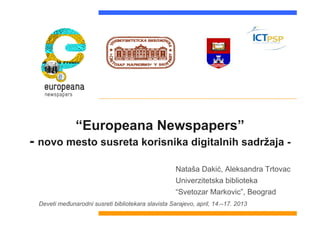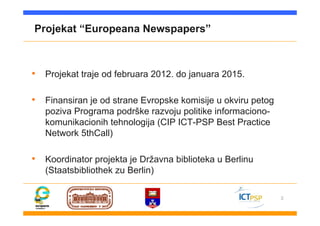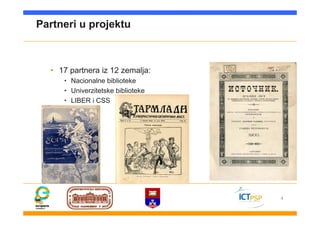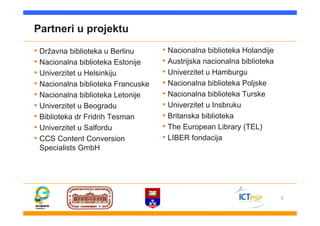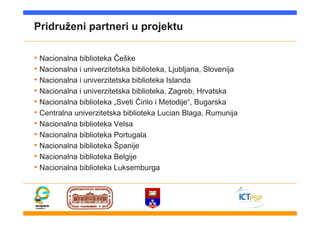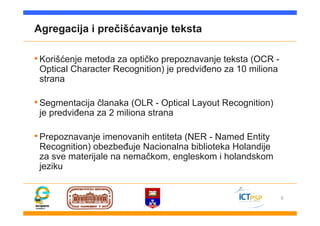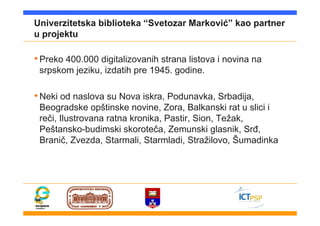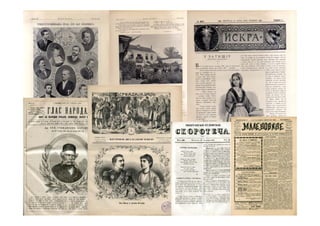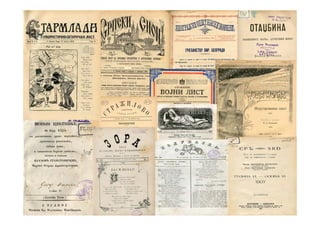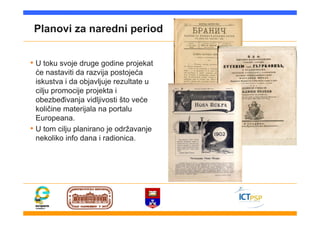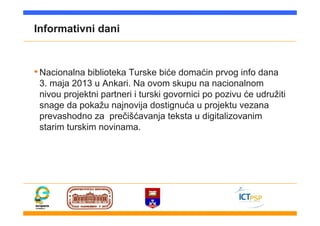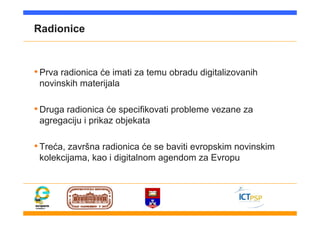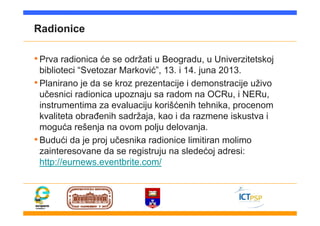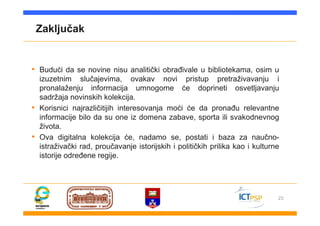Europeana Newspapers: novo mesto susreta korisnika digitalnih sadréƒaja
- 1. ãEuropeana Newspapersã - novo mesto susreta korisnika digitalnih sadréƒaja - NataéÀa Dakiá, Aleksandra Trtovac Univerzitetska biblioteka ãSvetozar Markovicã, Beograd Deveti meáunarodni susreti bibliotekara slavista Sarajevo, april, 14.ã17. 2013
- 2. 2 Projekat ãEuropeana Newspapersã ZaéÀto novine? ã relevantan izvor informacija za sve graáane ã visoko relevantan izvor informacija za istraéƒivaáe Stanje novina u bibliotekama izmeáu raja i pakla ã solidni kompletni originali, izuzetne kopije na mikrofilmovima ã krti, lomljivi originali, nekompletni brojevi, suplementi
- 3. 3 Projekat ãEuropeana Newspapersã ã Projekat traje od februara 2012. do januara 2015. ã Finansiran je od strane Evropske komisije u okviru petog poziva Programa podréÀke razvoju politike informaciono- komunikacionih tehnologija (CIP ICT-PSP Best Practice Network 5thCall) ã Koordinator projekta je Dréƒavna biblioteka u Berlinu (Staatsbibliothek zu Berlin)
- 4. 4 Partneri u projektu ã 17 partnera iz 12 zemalja: ã Nacionalne biblioteke ã Univerzitetske biblioteke ã LIBER i CSS
- 5. 5 Partneri u projektu ã Dréƒavna biblioteka u Berlinu ã Nacionalna biblioteka Estonije ã Univerzitet u Helsinkiju ã Nacionalna biblioteka Francuske ã Nacionalna biblioteka Letonije ã Univerzitet u Beogradu ã Biblioteka dr Fridrih Tesman ã Univerzitet u Salfordu ã CCS Content Conversion Specialists GmbH ã Nacionalna biblioteka Holandije ã Austrijska nacionalna biblioteka ã Univerzitet u Hamburgu ã Nacionalna biblioteka Poljske ã Nacionalna biblioteka Turske ã Univerzitet u Insbruku ã Britanska biblioteka ã The European Library (TEL) ã LIBER fondacija
- 6. Pridruéƒeni partneri u projektu ã Nacionalna biblioteka áeéÀke ã Nacionalna i univerzitetska biblioteka, Ljubljana, Slovenija ã Nacionalna i univerzitetska biblioteka Islanda ã Nacionalna i univerzitetska biblioteka, Zagreb, Hrvatska ã Nacionalna biblioteka ãSveti áirilo i Metodijeã, Bugarska ã Centralna univerzitetska biblioteka Lucian Blaga, Rumunija ã Nacionalna biblioteka Velsa ã Nacionalna biblioteka Portugala ã Nacionalna biblioteka é panije ã Nacionalna biblioteka Belgije ã Nacionalna biblioteka Luksemburga
- 7. 7 Ciljevi projekta ãEuropeana Newspapersã ã Europeana áe postati najveái provajder panevropskih novinskih kolekcija ã Istraéƒiti stanje novinskih zbirki u evropskim bibliotekama ã Obezbediti kvalitetne kopije i doneti preporuke za dalji rad éÀto se tiáe digitalizacije, preáiéÀáavanja teksta, metapodataka... ã PoboljéÀati pristup zbirkama novina u Evropi
- 8. 8 Ciljevi projekta ãEuropeana Newspapersã ã Tokom projekta Evropskoj biblioteci (TEL ã The European Library) i Europeani áe biti dostavljeno oko 18 miliona digitalizovanih strana novina od kojih su mnoge u punom tekstu
- 9. 9 Agregacija i preáiéÀáavanje teksta ãÂKoriéÀáenje metoda za optiáko prepoznavanje teksta (OCR - Optical Character Recognition) je predviáeno za 10 miliona strana ãÂSegmentacija álanaka (OLR - Optical Layout Recognition) je predviáena za 2 miliona strana ãÂPrepoznavanje imenovanih entiteta (NER - Named Entity Recognition) obezbeáuje Nacionalna biblioteka Holandije za sve materijale na nemaákom, engleskom i holandskom jeziku
- 10. NER - Named Entity Recognition
- 11. Metapodaci ãÂRazvoj i unapreáenje standarda za opis tehniákih metapodataka za optiáko prepoznavanje teksta - METS/ALTO ãÂDalji razvoj Evropskog modela za metapodatke (EDM - European Data Model) i usaglaéÀavanje sa METS/ALTO standardom ãÂTransformacija lokalnih metapodataka u EDM model
- 12. Pristup do punog teksta ã Sloéƒena pretraga sadréƒaja punog teksta preko: ã Kljuánih reái ã Imenovanih entiteta ã Zbirki novina ã Datuma, godine... ã Pregledanje svake pojedinaáne stranice ã Povezivanje sa relevantnim biblioteákim izvorom
- 13. Univerzitetska biblioteka ãSvetozar Markoviáã kao partner u projektu ãÂPreko 400.000 digitalizovanih strana listova i novina na srpskom jeziku, izdatih pre 1945. godine. ãÂNeki od naslova su Nova iskra, Podunavka, Srbadija, Beogradske opéÀtinske novine, Zora, Balkanski rat u slici i reái, Ilustrovana ratna kronika, Pastir, Sion, Teéƒak, PeéÀtansko-budimski skoroteáa, Zemunski glasnik, Srá, Braniá, Zvezda, Starmali, Starmladi, Straéƒilovo, é umadinka
- 14. ÅůîţŃÅýŧÅç îîîůŧÅç ŧŃÅýšŧů - îţšŤÅç
- 16. Kriterijumi za izbor graáe ã Naslovi koje nije digitalizovala Narodna biblioteka Srbije ã Oáuvanost novina ã Tehniáka ograniáenja
- 17. DosadaéÀnji rezultati projekta ãÂustanovljeni su odreáeni radni tokovi i tehniáki procesi ã preciziran je obim i broj digitalizovanih novina koje su predviáene za obradu naprednim tehnologijama ãÂizvréÀena je procena kvaliteta ovih materijala ãÂdefinisani su moguái modeli metapodataka koji áe se koristiti prilikom agregacije kao i naáini prikaza digitalizovanih sadréƒaja ãÂuraáena je i specifikacija zahteva za optiáko prepoznavanje karaktera (OCR)
- 18. DosadaéÀnji rezultati projekta ã Anketa ã Sprovedena je anketa koja je imala za cilj identifikaciju i analizu svih novinskih kolekcija koje su digitalizovale nacionalne, akademske i javne biblioteke u Evropi do 2012. godine. U anketi je uáestvovalo 47 institucija ã Rezultati: ã Pristup digitalizovanim novinama je skoro uvek besplatan u 85% sluáajeva ã 36% biblioteka nije koristilo nijednu vrstu optiákog prepoznavanja karaktera (OCR) na digitalizovanom novinskom sadréƒaju
- 19. Planovi za naredni period ã U toku svoje druge godine projekat áe nastaviti da razvija postojeáa iskustva i da objavljuje rezultate u cilju promocije projekta i obezbeáivanja vidljivosti éÀto veáe koliáine materijala na portalu Europeana. ã U tom cilju planirano je odréƒavanje nekoliko info dana i radionica.
- 20. Informativni dani ãÂNacionalna biblioteka Turske biáe domaáin prvog info dana 3. maja 2013 u Ankari. Na ovom skupu na nacionalnom nivou projektni partneri i turski govornici po pozivu áe udruéƒiti snage da pokaéƒu najnovija dostignuáa u projektu vezana prevashodno za preáiéÀáavanja teksta u digitalizovanim starim turskim novinama.
- 21. Radionice ãÂPrva radionica áe imati za temu obradu digitalizovanih novinskih materijala ãÂDruga radionica áe specifikovati probleme vezane za agregaciju i prikaz objekata ãÂTreáa, zavréÀna radionica áe se baviti evropskim novinskim kolekcijama, kao i digitalnom agendom za Evropu
- 22. Radionice ãÂPrva radionica áe se odréƒati u Beogradu, u Univerzitetskoj biblioteci ãSvetozar Markoviáã, 13. i 14. juna 2013. ãÂPlanirano je da se kroz prezentacije i demonstracije uéƒivo uáesnici radionica upoznaju sa radom na OCRu, i NERu, instrumentima za evaluaciju koriéÀáenih tehnika, procenom kvaliteta obraáenih sadréƒaja, kao i da razmene iskustva i moguáa reéÀenja na ovom polju delovanja. ãÂBuduái da je proj uáesnika radionice limitiran molimo zainteresovane da se registruju na sledeáoj adresi: http://eurnews.eventbrite.com/
- 23. 23 Zakljuáak ã Buduái da se novine nisu analitiáki obraáivale u bibliotekama, osim u izuzetnim sluáajevima, ovakav novi pristup pretraéƒivavanju i pronalaéƒenju informacija umnogome áe doprineti osvetljavanju sadréƒaja novinskih kolekcija. ã Korisnici najrazliáitijih interesovanja moái áe da pronaáu relevantne informacije bilo da su one iz domena zabave, sporta ili svakodnevnog éƒivota. ã Ova digitalna kolekcija áe, nadamo se, postati i baza za nauáno- istraéƒivaáki rad, prouáavanje istorijskih i politiákih prilika kao i kulturne istorije odreáene regije.
- 24. ã Detaljnije informacije na: ÿ http://www.europeana-newspapers.eu/

